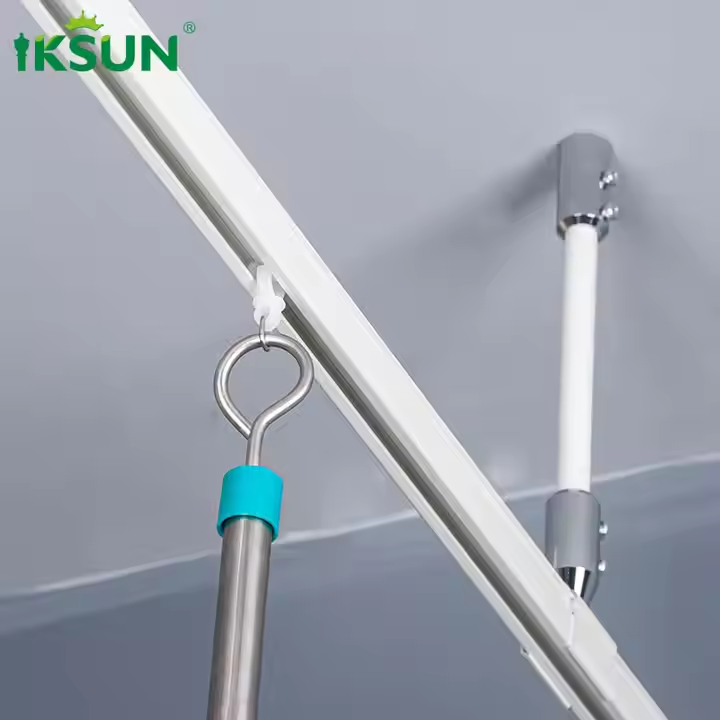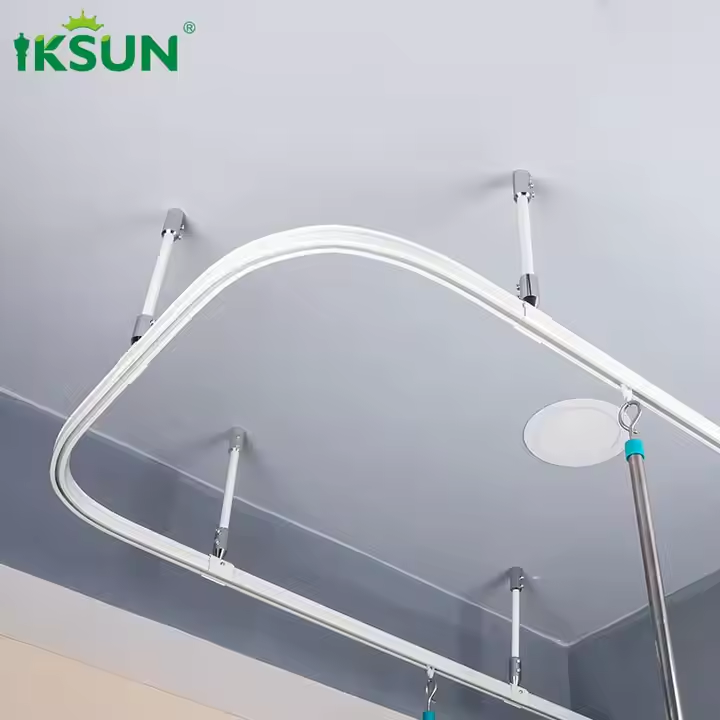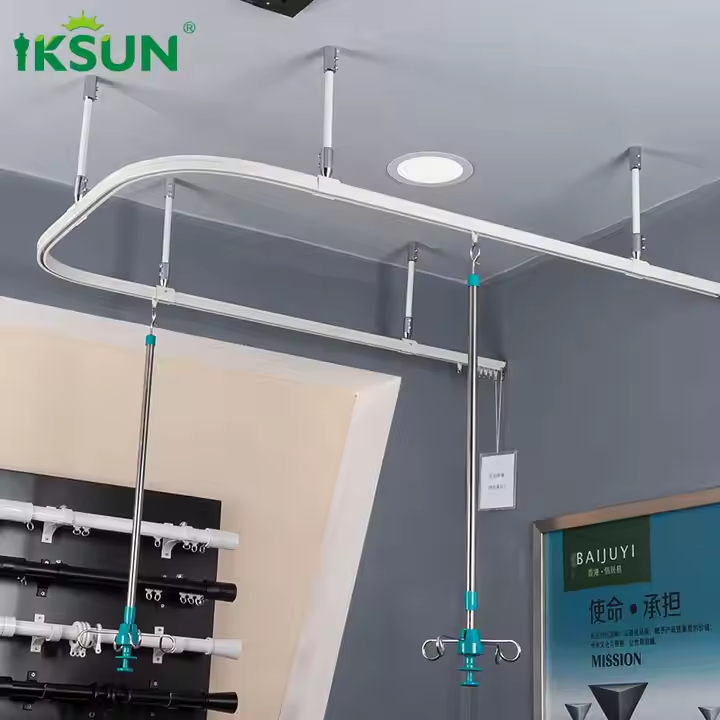Whether in the emergency room, general wards, or intensive care units, the curtain track system plays a crucial role: providing a privacy barrier for patients, assisting in the division of medical Spaces, and supporting rapid response when necessary.
This article will delve into the types, standards, selection strategies, and practical applications of hospital curtain tracks from multiple perspectives, helping you gain a more comprehensive understanding of this unremarkable yet important system.
1. What Are Hospital Curtain Tracks?
Hospital curtain tracks are specialized track systems installed on ceilings or walls in medical facilities to suspend privacy curtains. They’re not just for show—they play a critical role in maintaining patient dignity, controlling infection, and optimizing workflow. From patient rooms and emergency bays to intensive care units and outpatient clinics, these tracks are everywhere.
At first glance, they might seem like regular curtain rods. But the real difference lies in their design, materials, and how they’re used. In hospitals, curtain tracks must be durable, flexible in configuration, and easy to clean. That’s because they’re part of the medical infrastructure—used daily, cleaned frequently, and essential to patient care.
2. What Are the Requirements for Hospital Curtain Tracks?
In a hospital, nothing is left to chance—including curtain tracks. They must meet a strict set of requirements:
a. Hygiene and Infection Control
Curtain tracks must be easy to sanitize. Infections can spread easily in hospitals, so surfaces—including tracks—must not harbor bacteria. Tracks made from anodized aluminum or antimicrobial-coated materials are preferred.
b. Safety
Tracks must support flame-retardant curtains and should themselves comply with fire-safety standards. They should also have a “breakaway” or quick-release mechanism for emergency situations, such as when medical staff need fast access to a patient.
c. Durability
Hospitals are 24/7 environments. Tracks must withstand years of continuous use, including the regular pulling of heavy curtains and exposure to disinfectants. Flimsy options just won’t do.
d. Flexibility
Layouts change. A modular ICU today may become a step-down ward tomorrow. Curtain tracks must adapt to various configurations, whether straight, curved, or L-shaped.
3. What Types of Curtain Tracks Are Suitable for Hospitals?
| Type | Installation Method | Typical Applications | Advantages | Considerations |
|---|---|---|---|---|
| Ceiling-Mounted Tracks | Mounted directly on the ceiling | Patient rooms, ICUs, ERs, prep areas | Space-saving, easy to clean, flexible layout, strong support | Requires precise installation; avoid interference with lights/HVAC |
| Recessed Curtain Tracks | Integrated into the ceiling | VIP rooms, high-end wards, and surgical areas | Sleek appearance, dust-resistant, hygienic | Higher cost; must be planned during early construction phase |
| Free-Standing Tracks | Floor-supported frame | Temporary clinics, field hospitals, isolation | Mobile, quick to deploy, no ceiling work required | Less stable; not ideal for long-term use; occupies floor space |
| Cubicle Curtain Tracks | Ceiling-mounted with drop rods | Multi-bed wards, recovery areas | Standard hospital setup, sturdy structure, easy to segment private areas | Requires regular maintenance of carriers and rods |
| Wall-Mounted Tracks | Attached to wall brackets | Older buildings, psych units, space-limited zones | Simple structure, suitable where ceilings can’t be used | Limited coverage; may interfere with wall-mounted equipment |
| Motorized Curtain Tracks | Ceiling-mounted or recessed | Smart hospitals, premium patient suites | Hands-free operation, reduces cross-contamination, compatible with automation | Expensive; requires electrical setup and professional installation |
4. How to Choose the Right Hospital Curtain Track?
Choosing the right curtain track is about balancing needs, budget, and environment. Here’s a practical framework:
a. Understand the Usage
Is the space permanent or temporary? Will it host critical patients? For permanent setups like surgical wards, choose ceiling-mounted aluminum tracks with antimicrobial properties.
b. Consider Maintenance
Tracks should allow for quick curtain changes. Choose systems compatible with curtain carriers that glide smoothly and don’t jam easily. For example, nylon wheel carriers are quieter and reduce resistance.
c. Check Compatibility with Existing Infrastructure
Before selecting a track, ensure it works with your ceilings, lighting, and HVAC layout. For false ceilings, recessed or suspended tracks are usually best.
d. Review Safety and Compliance
Ensure the track system complies with local fire codes, load-bearing regulations, and infection-control standards. Some systems also include sealed track housings to prevent dust accumulation.
e. Budget Wisely
Lower-cost tracks may seem appealing, but often lead to higher maintenance. A hospital in Kuala Lumpur faced costly downtime due to inferior tracks that warped within two years
5. Installation Methods and Key Considerations
Installing curtain tracks in a medical environment requires attention to detail and expertise.
a. Ceiling vs. Wall Installation
Ceiling mounting is preferred, but in older buildings or special cases (e.g., psychiatric units), wall-mounted tracks might be necessary. These must be securely anchored to handle stress.
b. Drop Rods and Suspension Kits
When ceilings are too high or uneven, drop rods help maintain stability. Use stainless steel or powder-coated rods for durability.
c. Track Curves and Connectors
Precision is vital. Tracks must follow the intended path exactly, especially around beds or corners. Use smooth aluminum connectors for bends, avoiding plastic ones that can crack.
d. Infection Control During Installation
Installers must wear protective gear, especially in active medical zones. All drilling debris should be cleaned immediately. Tracks should be sanitized post-installation.
e. Regular Checks and Maintenance
Schedule annual inspections. Look for signs of corrosion, jammed carriers, or loose mounts. Hospitals that follow a maintenance routine typically avoid costly emergency repairs.
6. What Curtain Track Options Does IKSUN Offer?
IKSUN provides a professional range of hospital curtain tracks designed for reliability, hygiene, and ease of use. Without getting too promotional, here’s a peek at what differentiates quality systems:
-
Aluminum Anodized Tracks: Lightweight yet strong, perfect for ceiling installations.
-
Integrated Glide Systems: Reduce curtain drag and noise.
-
Modular Components: For quick field adjustments and layout changes.
-
Antimicrobial Coatings: Extra protection in sensitive environments like NICUs and burn units.
If you’re curious, you can learn more about IKSUN’s hospital solutions here.
7. Conclusion
Choosing the right curtain track system in a hospital isn’t just about function—it’s about safety, hygiene, flexibility, and long-term value. Whether you’re building a new facility or upgrading an old one, investing in the right infrastructure can make a tangible difference in patient care.
Let’s recap:
-
Hospital curtain tracks need to be durable, cleanable, and flexible.
-
Ceiling-mounted and cubicle tracks are most common, but each type serves a specific need.
-
Track selection should always consider safety, compliance, and maintenance.
-
Proper installation ensures longevity and infection control.
-
Reliable vendors provide systems that meet clinical demands without overcomplicating setup or upkeep.
For more information and product catalogs, please contact us!


